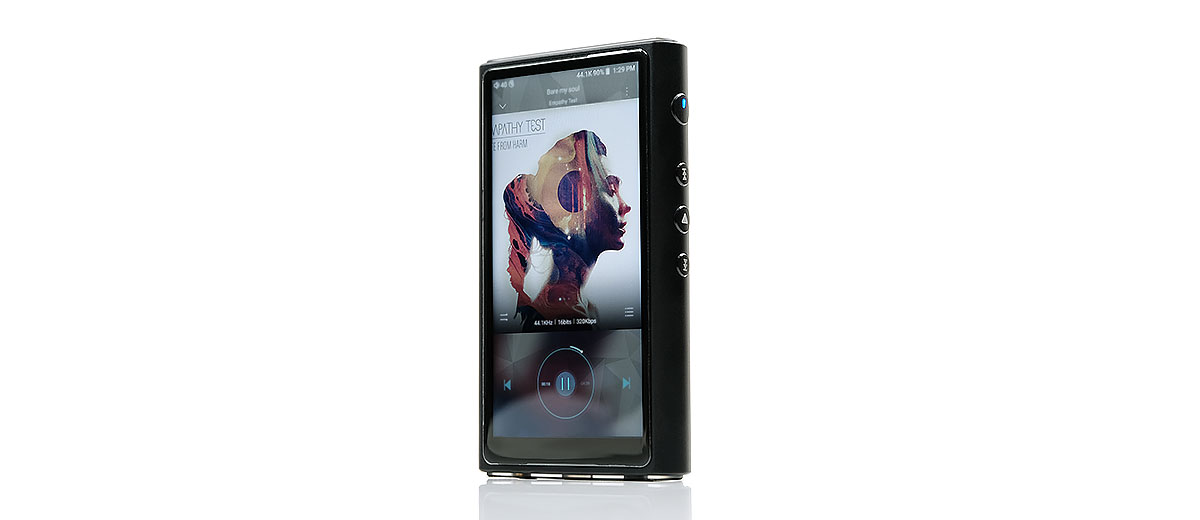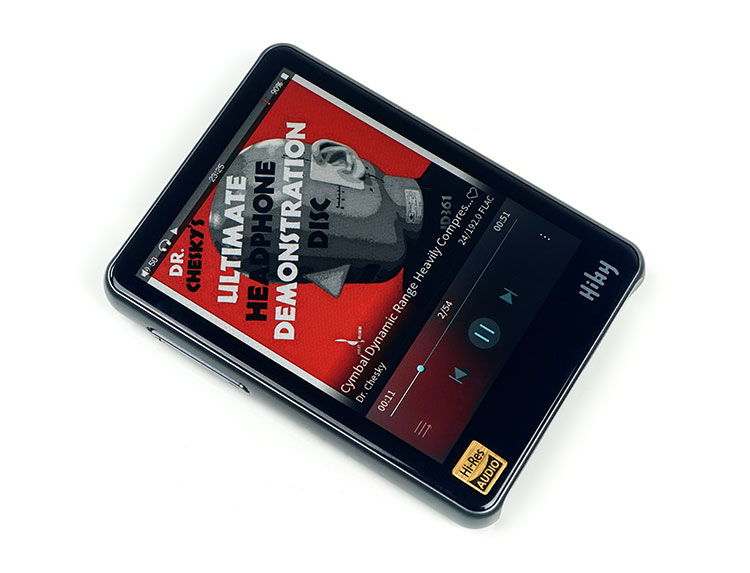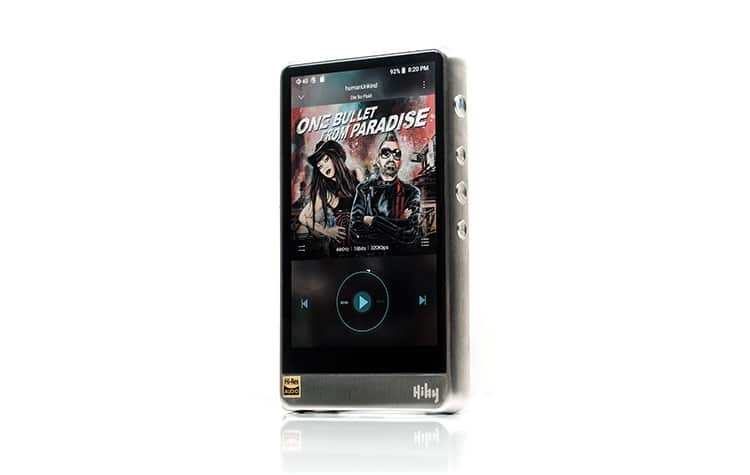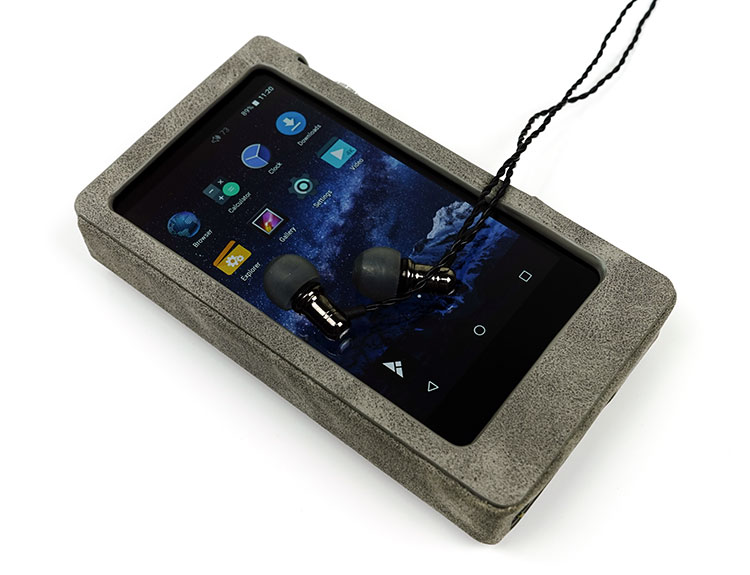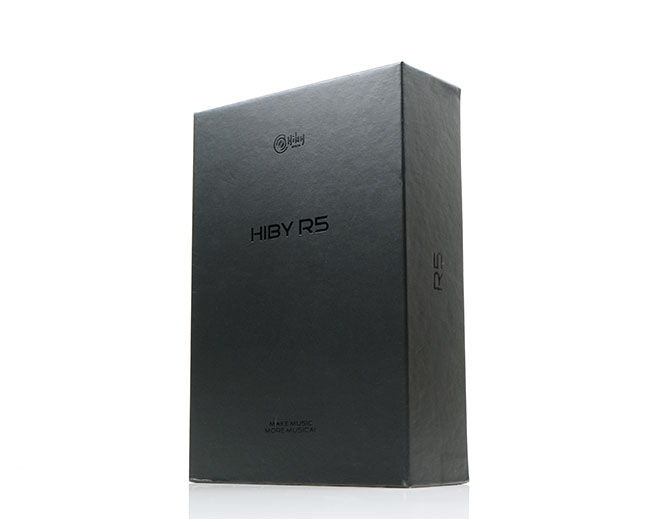Select Comparisons
HiBy R3
$229
Technical
The R3 is smaller, lighter, and costs a bit less at $229. It uses a single ES9028Q2M DAC as compared to the R5’s dual CS43198 chip implementation and has an output power rating of a maximum 112mW+112mW in balanced mode 2.5mm TRRS. It can decode up to native DSD256 and PCM 384kHz/32bit as well as handling MQA with a recent firmware update.
The R5 is a monster compared to the R3 for output power at 564mW+564mW on a 32Ω load using 4.4mm. It can also decode up to DSD256 and PCM 384kHz/32bit.
The R3 also has no onboard memory whereas the R5 has 16GB. Battery life on the tiny 1600mAh R3 is pretty good actually at around 8-9 hours (closer to 7 for me under heavy usage). However, the R5’s 3500mAh Li-polymer using Quick Charge 3.0 (QC3.0) technology will last longer, with a rated spec of 11-18 hours balanced or unbalanced. Just be warned, the R5 does get hotter under heavy usage compared to the R3.
Software
The R3 uses HiBy’s own OS compared to the open Android Oreo 8.1 of the R5. The HiBy OS has come a long way in the last few years with excellent functionality such as BT, WiFi, and TIDAL. If anything, you can think of HiBY OS as an expansive HiBy Music app with features such as MSEB, DLNA, and Airplay all available as you would find them in the HiBy Music app.
TIDAL integration is ok on the R3 but not the full experience as you will find on the R5 Android version. The one key TIDAL feature the R3 has right now is MQA compatibility which the R5, right now, does not currently have. I expect the R5 will get it eventually.
Performance
The first point is a relatively quick one. The R5 can drive most headphones of an impedance level 32Ω with much better authority than the R3. Planars such as the Ananda, SINE DX and iSINE/LCDi4 sound ok on the R3 but the better dynamic range on the R5 is apparent from the offset and will deliver more headroom by comparison.
The R5 also has less low-level hiss than the R3 using unbalanced 3.5mm TRS and the Campfire Audio Solaris, which is my most sensitive monitor. Not that the R3 hisses much but the R5 does have the blacker background.
The R3 2.5mm TRSS balanced output played out in much the same manner with a slightly higher level of background hiss than the 4.4mm R5 counterpart. Given the lack of output power and similar low impedance outputs I am surprised by that outcome but in a very good way.
Both DAPs deliver black backgrounds with less efficient monitors such as the 112dB SPL DUNU DK-4001 and the 97dB SPL CA Comet in both balanced and unbalanced mode.
Tuning
A few interesting differences here in the tuning of these two DAPs. Using a CA Solaris as our test monitor the R5 sounded slightly more linear, with a little less low-end bloom with a more solid natural-sounding midrange timbre. Overall, I felt the R5 to have a better instrumental body, particularly in the lower-mids of the Solaris.
Treble is also a touch softer in overtones than the R3 and that affects the instrumental timbre a bit also. I tended to find the R3 deliver a slightly drier more digital sound than the wetter, longer decay of the R5 tuning.
Also, that comparative slight treble fade delivers a more euphonic vocal tone on the R5. The R3 treble presence offers more of an odd-harmonic lift from the mids onwards sounding the slightly brighter of the two but not by a huge amount.
Probably the one constant throughout the nuanced timbral differences was the dynamic range both of their amp stages offer. The R5 amp stage has a better level of dynamic range, everything has a bit more “pop” and snap to the sound whereas the R3 has excellent detail but can often just seem a shade flatter in its delivery.
HiBy R6 Pro
$799
Technical
This is HiBy’s current flagship DAP using a dual ES9028Q2M implementation and a maximum of 750mW+750mW(@32Ω) balanced and 245mW+245mW(@32Ω) unbalanced. It is much bigger (Stainless steel version), heavier but with a larger screen and a dedicated coaxial/LO jack rather than the R5 shared jacks.
The R5’s dual CS43198 implementation still offer similar decoding levels as the R6 Pro at DSD256 and PCM 384kHz/32bit as well as both being able to use HiBy’s DTA architecture for bit-perfect output.
The R6 Pro has a more powerful output compared to the 564mW+564mW and the 148mW unbalanced R5 output on a 32Ω load. The SNR, however, is better on the R5 at 120.5dB unbalanced compared to 118dB on the R6 Pro. Similar slight advantages in the supplied line-out numbers also with 127.8dB on the R5 compared to 122dB on the R6 Pro.
Both have QC3.0 quick charge batteries though the R5 will last a little bit longer despite being the more powerful DAP with smaller battery size. The larger screen of the R6 pro is likely to be a bigger factor in battery life given both have the same 1.4GHz CPU clock rates.
Software
Both have the exact same setup with Snapdragon 425 and open Android Oreo. The only key difference is 1GB less on the R5 RAM which might slow it down if you have a ton of apps open the same time. Our performance tests suggest that otherwise, both operate just as smoothly as each other. My only concern is the size of the screen for Android on the R5 is quite a bit smaller and perhaps harder to read as a result.
In terms of expandability, the R5 has less onboard memory at 16GB (less than 10GB available) compared to the 32GB of the R6 Pro but both have external memory card slots and can integrate OTG flash and external HDD expansion. Both have WiFi and BT for bi-directional and HiBy Link support as well as DLNA or pretty much any service you can get from their integrated Google Play Store.
Performance
The R6 Pro has a much higher level of background noise or hiss than the R5 in either balanced or unbalanced output using the Solaris as our test monitor. The gap is moot once you insert a much less sensitive or higher impedance monitor such as the DUNU DK-4001 and you get a black background and zero hiss on both with the 97dB SPL CA Comet.
Headphone performance is a different story with the R6 Pro balanced output sounding like it packs a bit more punch and gain compared to the R5 using the Hifiman HE1000 V2 which is rated at 35Ω and 90dB. The R6 Pro maybe edges ahead on demanding planar headphones. Not only did the R6 Pro sound fuller due to the timbral differences but the dynamic range, SPL and headroom are all better than the R5 using 4.4mm outputs.
If you are driving sub-100dB SPL planars like the HE1000 series I would pick the R6 Pro balanced. For the likes of Audeze’s SINE and Ananda then the R5 4.4mm should be fine.
Tuning
The R5 sound is more neutral with not quite as much low-end weight and a little bit more upper-mids and treble presence. It has less of that natural treble roll-off that the R6 Pro was tuned in mind with and a little less warmth in comparison. I still find the timbre of the R5 fairly natural in tone but not quite as wet and rich in detail as the R6 Pro’s tuning.
With that slightly peppier treble, the R5 is also a little lighter and cleaner in tone for vocals. Though I wouldn’t classify the R5 in anyway peaky or bright you will find a slightly higher level of sibilant effect on high pitched vocals compared to the R6 Pro’s smoother harmonic balance.
One example I keep using is the Solaris pairing using CHVRCHES “Miracle” and Lauren Mayberry’s waif-like solo vocal 30-second opening to the track. On the R6 Pro, the texture and level of detail in the vocal is excellent with very little in the way of sibilance. With the R5, the timbre is close but you can hear a little harmonic clash that results in a little more focus on sibilant qualities on “V” and “S’s”.
FiiO M11
$449.99
Technical
The M11 is FiiO’s latest mid-fi DAP and at a slightly higher price of $449.99. It is bigger with more of a smartphone presentation and weighs about 50g more than the R5 which is more pocketable. Mind you, the screen size of the M11 at 5.15″ compared to 4.2″ is much easier to read and use for Android apps and typing. PPI on both screens are almost the same though at 312 for the M11 and 319 for the R5.
Both DAC’s use a dual implementation with the M11 using a dual AK4493EQ compared to the R5’s dual CS43198. The decoding capability of both is the same with both capable of up to DSD256 and PCM 32/384kHz.
I like the fact the M11 has that additional 2.5mm TRSS port as well as 4.4mm and 3.5mm. It does provide more connection options compared to the R5. The output power on the R5 amp stage is similar at 1564mW on a 32Ω load going balanced compared to the M11’s 550mW 32Ω balanced load. SNR is a touch higher on the R5 at 120.5dN unbalanced compared to 118dB on the M11.
The Samsung Exynos 7872 14nm CPU combined with 3GB of RAM makes the M11 the fastest performer of the two, and the fastest DAP we have ever tested using AnTuTu with over double the performance score of the Snapdragon 425 inside the 2GB R5.
Onboard memory is higher at 32GB compared to the R5’s 16GB with dual memory card slots on the M11 compared to a single slot on the R5. Both have Quickcharge QC3.0 technology with the R5 doing slightly better on paper with up to 18 hours unbalanced compared to 13 hours for the M11.
Software
A big difference here with the M11 using Android 7 without Google Play support compared to the R5’s Oreo with Google Play integration. You can use APK Pure on the M11 but you will find some apps are not 100% compatible as they rely on Google Play services for operability such as HiFi Cast DLNA services. The additional 1GB of RAM will be a bonus to the M11 in terms of multitasking stability and it is much faster than the R5 for performance, (AnTuTu).
Both are WiFi and BT capable with bi-directional support with the M11’s using the FiiO Music player and HWA and HiBy using HiBy Music app, HiByLink and their own UAT BT protocol as well as HWA. Both offer LDAC out of the box also.
Performance
With my trusty hiss-o-meter or the CA Solaris I can tell you that in both balanced and unbalanced modes the M11 emits more noise or background hiss than the R5. The M11 isn’t bad actually but it is more noticeable. It is one of the excellent talking points about the R5 performance is just how low they got that noise level with the amount of power they are running through the amp stage.
By the time you switch up to something like the DUNU DK-4001 noise is a non-issue for either DAPs and in the case of our final test IEM, the CA Comet you will get a completely black background with both.
Tuning
The tuning of these two DAPs are more alike than different initially but there are some differences that you can pick up on after some longer listening sessions.
Using our test monitors, the CA Solaris, and the DUNU DK-4001 the R5 seems to have a smidgen less treble amplification and energy. This means the M11 could well display a touch more contrast and headroom with monitors over the R5 but it also means the harmonic balance is just shade cooler or harder-edged for percussion and some vocals pitching.
Not by much mind you, it is very slight in the way the R5 upper mids sound a little wetter, not quite as amplified as the M11 on our sample track from the R6 Pro session, CHVRCHES “Miracle” and Lauren Mayberry’s delicate vocal intro solo. The AK4493EQ is not as bombastic as the older AK4490EQ nor as hard-edged on the upper mids and lower treble but it still has a slight fusion of that legacy sound.
The other difference is in the low-end. I find the M11 just to be a little more neutral in its impact and weight whereas the R5 has a touch more body and warmth. That R5 additional body and warmth does alter the timbre slightly into the mids on the R5 sounding a little more even harmonic and the M11 more neutral in overtone.
iBasso DX150
$499
Technical
I am not sure how long the DX150 will be available given the pending arrival of the DX160. The DX200 was phased out in favor of the DX220, however, the DX160 does not have the amp card system whereas the DX150 does so it might stay.
That being said, it is a worthy comparison to the R5 with the stock AMP6 card at $499. This is a huge DAP compared to the R5 by the way and much heavier also. The R5 is very pocketable by comparison though with a much smaller screen. The R5’s amp stage is fixed unlike the Dx150’s flexible amp card system though you do need to AMP8 to get 4.4mm balanced whereas the R5 comes with 4.4mm out of the box.
The DX150 uses 64bit 8 Cores A53 processor and 2GB of RAM with a clock cycle rate capped currently at 216-1008Mhz. At 1.4Ghz, the 2GB Snapdragon 425 of the R5 is faster and will feel snappier during daily usage. Battery life is also much better on the R5 with up to 18 hours compared to around 10-11 hours on the DX150. Both have fast charging tech, however, the DX150 uses PD2.0, compatible with QC2.0, whereas the R5 uses QC3.0.
DAC & Amp
The DX150 uses a dual 32-bit AKM AK4990EQ implementation which is an oldie but a goodie for chipsets. It’s decoding is just as good as the dual CS43198 of the R5 at up to DSD256 and PCM 32BT/384kHz.
Balanced output power is higher on the R5 compared to the stock AMP6 card that comes with the DX150 and slightly lower unbalanced. The AMP6 is rated at unbalanced at 2.4Vrms with a 32Ω load and balanced at 3.7Vrms, (maximum output). That’s about 180mW unbalanced and 430mW balanced is they are correctly weighted by iBasso.
THD+N is higher on the R5 at 0.0014% compared to the AMP6’s excellent 0.0004% but the AMP6’s SNR is a touch lower at 118dB compared to 120.5dB unbalanced for the R5.
Software
Both use Oreo as their main platform with the DX150 having the additional dual boot into dedicated Mango OS whereas the R5 only has Android. The R5, however, has Google Play integrated whereas the DX150 does not so you need APK Pure or equivalent for apps management and you might lose some app compatibility also on the DX150. Despite both having 2GB, the R5 is much snappier with its better CPU clock rate.
Both have bi-directional BT and WiFi, however, the additional HiByLink is a feature iBasso have yet to match in their software development. Both do have bit-perfect output on their OREO platforms which is a welcome bonus in iBasso’s recent firmware upgrades.
Performance
Before I go onto the performance detail I have to give a shout out to iBasso for their volume control on the DX150. Compared to the R5 you have much better micro-adjustment capability whereas the R5 seems to jump up and down just that bit too much on a step by step basis with sensitive monitors. I kind of wish I had a few more micro-steps on the R5 volume like the DX150 offers.
For sensitive IEMs both the 3.5mm TRS output on both DAPS are excellent performers for noise with very low hiss levels paired with the CA Solaris. I would give a slight edge to the DX150 unbalanced but not by much. For balanced the story is quite different with the DX150 2.5mm TRS delivering much higher levels of hiss compared to the R5’s 4.4mm output.
The R5 balanced is much better suited to highly sensitive IEMs. As with our other tested monitors, the DUNU DK-4001 and CA Comet, we had pretty low noise floors with both DAPs, particularly the Comet.
The R5 has a bit more power for headphones such as the HE1000 V2 and slightly more headroom as a result. The DX150 also seems to show off a slightly leaner lower treble than the R5 with the HE1000 V2 going balanced but that might be more to do with the comparative the drop in the DX150’s output power.
Tuning
The tuning on the R5 is more to the neutral natural side with a bit more upper treble energy and slightly less bass warmth compared to the AMP6/DX150 combo.
Using the Solaris as the test monitor, the DX150 sounded the fuller of the two and closer to the R6 Pro style of timbre with a little more fade in its upper treble and a bit more of a euphonic lower-mids timbre.
That little treble lift and more neutral tuning of the R5 comes through on instrumental notes which sound just a little bit lighter and leaner in tone compared to AMP6/DX150. You also get a slightly more sibilant or odd-harmonic overtone on female vocals compared to the wetter euphonic DX150 presentation.
The low-end of both DAPs have a good extension and you won’t find either lacking for detail. However, in terms of elevation, the DX150 sub-bass has the better quantity and combined with the Solaris has the slightly more authoritative fundamental compared to the R5’s more linear delivery.
Our Verdict
Pardon the use of a meme here but the R5 is a bit of a pocket rocket and excellent value for $399. I am sure the competition will catch up but Android 8.1, HiBy MSEB, 0.5mW of output power and a very low noise floor has got to tick plenty of boxes for the avid DAP user.
The build is excellent and the size is pocketable, perhaps too pocketable? I know Android is awesome but for far-sighted people like me, it is a strictly glasses affair reading some of the fine print in the apps on that diminutive screen. A minor bugbear and sorry to the 20:20 users for what may well be a moot point.
It is not bug-free at this point and missing some key features I hope to see in forthcoming firmware. MQA would be a bonus feature and I am sure the licensing process for the R5 is underway given the R3 managed to deliver MQA at a later stage. The scanning of external memory cards seems overly slow for both MicroSD and OTG flash drives and the case does get more than a little warm at times. Finally, the BT Audio Input services did not work for me. I hope I am an exception for that last one. Chime in if you find yourself in the same situation.
Apart from that, the platform is quite mature, quite stable and boasting the kind of battery numbers that tempt me to take this, rather than the superb but connectivity-free Sony 1Z for long-distance flights. Shedding 300g from my carry-on bag and sucking the life out of the airport WiFi for TIDAL may just be on the horizon with the excellent R5.
HiBy R5 Technical Specifications
| Operating System | Android 8.1 |
| SoC | Snapdragon 425 |
| No. of CPU Cores | 4 |
| CPU Max Frequency | 1.4GHz |
| DAC | CS43198 x 2 |
| Input Method | Touchscreen |
| WIFI | 5GHz/2.4GHz supports IEEE 802.11 a/b/g/n protocols |
| Bluetooth | Bluetooth 4.2 |
| USB | Type C (USB2.0 data rate) |
| Display Size | 4.0 inches |
| Colors | 16 million colors |
| Topology | IPS |
| Resolution | 540*1080 |
| PPI | 300 |
| Touchscreen | Multitouch |
| RAM | 2GB |
| Internal Storage | 16GB |
| External Storage | Up to 512GB + via 1 micro SD card |
| Buttons | 6 physical buttons |
| Buttons Definitions | Power/Previous/Pause/Next/Volume Up/Volume Down |
| Headphone Out | 3.5mm |
| Balanced Headphone Out | 4.4mm |
| Line Out | 3.5mm LO |
| Balanced Out | 4.4mm LO |
| Digital Out | SPDIF (USB out) |
| USB | USB storage, USB DAC IN/OUT |
| Colors | Black/Gray/Gold |
| Dimensions | 107.7*61.2*15.6mm |
| Headphone Impedance Range | 16~300Ω |
| EQ Adjustments | 10 bands (±12dB) |
| Channel Balance | L 10dB to R 10dB |
| Gain Level | Low / High |
| USB DAC | PCM/DoP/Native |
| Power Supply | 9V/1.5A |
| Battery | 3500mAh |
| Charge Time | 2H |
| Charge Protocol | QC3.0 |
| Firmware Update | Over-the-air update |
| Text Size | Adjustable |
| 3rd Party Apps | Unrestricted access via Google Play and apk download |

